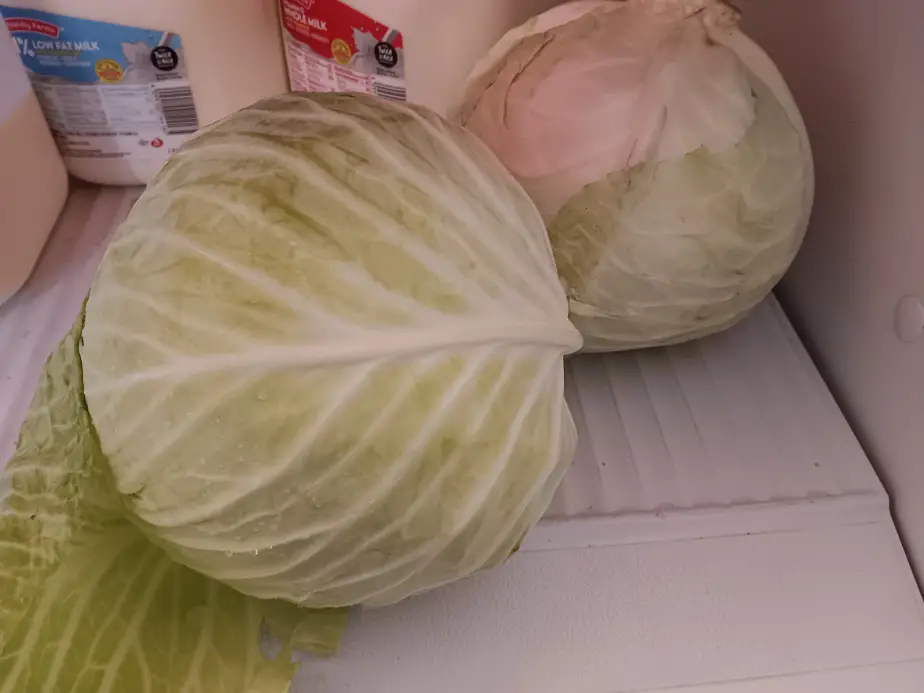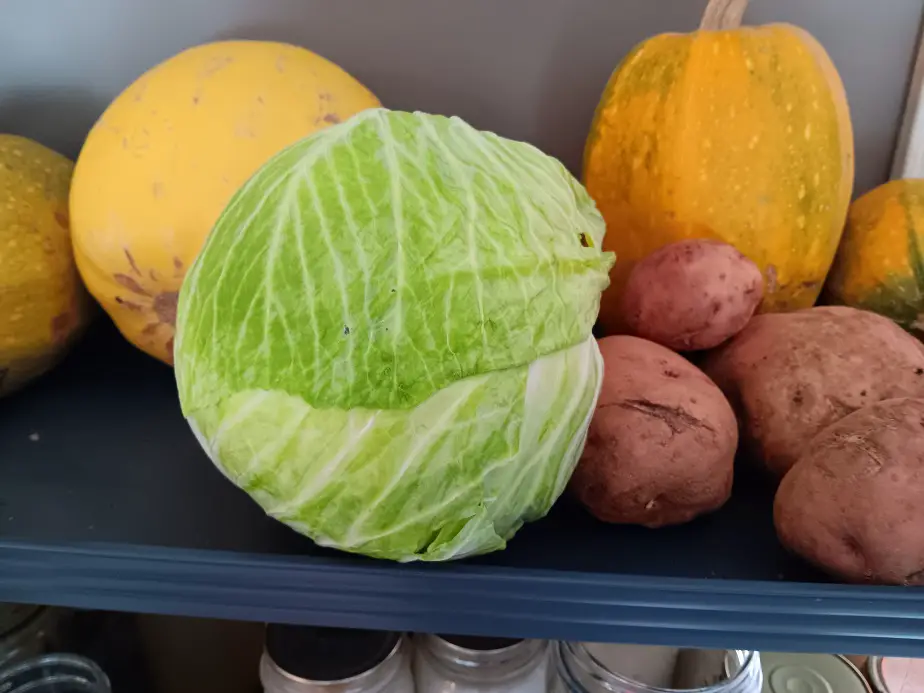Cabbage is our favorite vegetable for winter storage. I love a hot cabbage soup or cabbage and rice to warm the belly in February. Here’s how other people, as well as us, make them last from harvesting in September until the end of winter.
Store Cabbage in a Pantry
Contrary to popular belief, you can just put a fresh head of cabbage on a shelf and it will stay good for a while. The trick is to make sure it’s cool, dark, and not too dry. Even in sub-par conditions, I can keep a cabbage in decent condition on a pantry or cupboard shelf for a few weeks.
It works well enough if you want to use your cabbage in short order, and it’s very easy to do, but you can also make them last a lot longer just by adjusting the conditions a bit.
Cabbage can be kept for months in an unrefrigerated pantry if the air temperature is below 60 degrees and the humidity is 50 or above. If your pantry is too warm or dry, consider putting a shelving unit in your cellar, basement, or crawlspace. They usually keep a cooler and more humid atmosphere and are more conducive to longer-term storage of produce.
For us, the best place to store them like that would be on a shelf in my back bedroom (that we also use for storage). It’s the coldest room in my trailer-house, and it’s near the bathroom so the humidity is higher. The outermost leaves dry up and shrivel a bit, but the inside stays pretty good.
Don’t peel off the outer leaves unless they are rotting a bit. If they are just shriveling or getting soft, leave them. The outer guard leaves will help retain moisture on the inside, preserving its condition.
My mother used to store cabbage in the garage. it was unheated, but attatched to the house. The warm side of the garage was perfect for storing produce in the winter. I wish we had a garage now.
Cabbages have naturally high levels of a natural preservative called Absorbic Acid, or vitamin C. As the vitamin C breaks down, the cabbage becomes more prone to spoilage and rancidity. The biggest factor in the breakdown of Absorbic Acid, and therefore spoilage, is heat.
The cooler you can keep a cabbage, the longer it lasts. In commercial produce storage, cabbages are often stored at 36 degrees F, the same temperature as your common home refrigerator.
The more tightly controlled systems keep the temperature at or near 32 F, and regulate airflow and humidity to prevent freezing. That leads me to my next recommendation.

Make Use of a Spare Refrigerator
Cabbage will store 2-6 months in a refrigerator, depending on the type of cabbage and the humidity levels of the refrigerator. A large, storage-type cabbage stores exceptionally well in a refrigerator, and a spare refrigerator can store months worth of fresh cabbage for the home-grower.
I have, well, I had, a spare fridge in my shed that we used to store produce during the market season. Last year we filled it with leftover cabbage at the end of the season, around September, and used them in the kitchen until March or April. It was a larger fridge and I think I put around 50 heads in there.
They were perfectly fresh for quite a while. Eventually, the outer leaves started looking old so we just disregarded those before cooking up a cabbage soup or cabbage and rice. Now, since the refrigerator was just in an unheated shed, eventually everything froze. That was interesting.
I had thought that they were going to be ruined, but my wife had to try and we found out that they still cooked up fine even after being frozen solid. That ended up leading into my next experiment, storing whole heads of cabbage in the freezer.
Store Cabbage in a Freezer
You can store whole heads of cabbage in a freezer and they will last up to 6 months with no adverse effects on flavor or quality. Frozen cabbage is not good for eating uncooked, since it’s softer and soggy. After cooking, it’s indistinguishable from any other cabbage.
I’m a big fan of just chucking stuff in the freezer. My wife appreciates taking the time to chop or dice and to bag things in smaller portions first, but there’s so much going on getting ready for winter and bringing ion the last of the harvest that we don’t always have the time for that.
So, I will just toss entire heads of cabbage in the freezer. When we get them out, they have to be thawed slightly to trim or chop, and sometimes to peel off the outer leaves if they were dirty or just unpleasant. They seem to cook just fine, and they render down a little faster than a fresh head of cabbage.
When a frozen cabbage thaws, it has to be used quickly or it will go bad very fast. That’s the only downside is this. When you let one thaw, you have to use it that day.
As a man of strong German heritage, I love my cabbage. And let me tell you, It’s just fine and dandy after being frozen. I’ll take it any day!
Use a Root Cellar to Store Cabbage Long-Term
A root cellar can be a great way to store whole heads of cabbage. Root cellars tend to have better storage conditions than a basement or crawlspace because they’re usually more humid and cooler in the winter months. A good root cellar can store cabbage from fall until spring.
Most people don’t have a root cellar anymore. They’ve been mostly replaced by basements. and to tell you the truth, a basement can be pretty close to a root cellar for proper storage conditions. The difference is that you heat your home, which makes the basement warmer than your average root cellar.
Most furnaces also remove humidity from the home. That likely makes your basement dryer than if you just built a root cellar near your house. A good root cellar will keep out frost, remain humid, and keep the temperature consistent enough to avoid condensation. Condensation of produce leads to mold and spoilage.
Make a Cache-Trench to Store Cabbage In The Ground
I just talked to an older woman who told me they stored cabbage in a trench when she was a child. It’s something her parents had done when they were young. I’ve seen this same thing before with potatoes, but not cabbage. Here’s how it works.
You dig a trench below the winter frost line. For us, that’s about 4 feet. place a good pile of cabbage, then cover it with straw. You can either fill it to the top with straw or partially with straw and cover it with soil. When done right, it keeps out any freeze and keeps the humidity perfect.
One man who does this with potatoes every year in Pakistan said it helps to first make a layer of gravel or small stones to increase drainage in case it rains and to only trench in a place where water will never collect naturally. Straw or leaves will keep the moisture in, the frost out, and the dirt off your produce.
This method may not work well in a heavy soil that doesn’t drain well. I’d be more inclined to use it in sandy soil. When the pilgrims landed in America, they found a cache of indian corn buried in a mound of sand not far from the ocean shore. Burring in the ground is a very old, quite functional method of winter food storage if done right.
If You have any questions or comments, let me know in the comment section below. Thanks for reading, happy homesteading to ya.
Related Articles:

